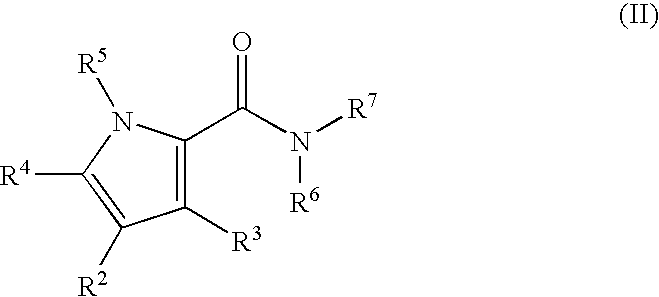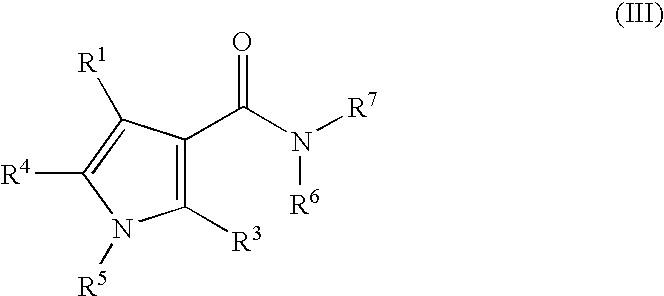Pyrrole Derivatives As Pharmaceutical Agents
a technology of pyrrole and derivatives, applied in the direction of drug compositions, immunological disorders, metabolism disorders, etc., can solve the problems of increased peripheral vascular resistance, increased load on the heart, increased reduced blood flow to the skeletal muscles, so as to reduce or eliminate one or more symptoms.
- Summary
- Abstract
- Description
- Claims
- Application Information
AI Technical Summary
Benefits of technology
Problems solved by technology
Method used
Image
Examples
example 1
Preparation of 1-(4-fluoro-2-trifluoromethyl-phenyl)-2,5-dimethyl-1H-pyrrole-3-carbaldehyde
[0381]
[0382]A. A mixture of 4-fluoro-2-(trifluoromethyl)aniline (4.4 g, 24.6 mmol), 2,5-hexanedione (2.8 g, 24.5 mmol) and acetic acid (0.28 mL) was heated to 100° C. After 3h the reaction mixture was cooled and partitioned between EtOAc and water. The organic layer was separated, dried (MgSO4), and concentrated in vacuo. The residue was purified by flash chromatography (SiO2), eluting with EtOAc / Hex (0:100 to 10:90) to afford 1-[4-fluoro-2-(trifluoromethyl)phenyl]-2,5-dimethyl-1H-pyrrole as a yellow oil (3.19 g, 50%); 1H NMR (CDCl3): δ 7.52 (dd, J=8, 3 Hz, 1H), 7.35 (dt, J=3, 8 Hz, 1H), 7.25 (dd, J=5, 8 Hz, 1H), 5.90 (s, 2H), 1.91 (s, 6H); MS (ESI) m / z 258 [M+H]+.
[0383]To anhyd DMF (10 mL) cooled under nitrogen to 0° C. was added phosphorous oxychloride (1.2 mL, 13.1 mmol). The resulting mixture was stirred at 0° C. for 30 min and then a solution of 1-[4-fluoro-2-(trifluoromethyl)phenyl]-2,5-...
example 2
Preparation of 2,5-dimethyl-1-[2-(trifluoromethyl)phenyl]-1H-pyrrole-3-carboxylic acid phenylamide and Variations
[0499]A. A 0.125 M stock solution of 1-[2-(trifluoromethyl)phenyl]-2,5-dimethyl-1H-pyrrole-3-carboxylic acid chloride was prepared in THF. Anilines and other heterocyclic amines were individually weighed and were dissolved to 0.125 M using a Tecan Genesis workstation and a 1.0 M diisopropylethylamine in THF solution. The Tecan was used to dispense 200 μL of 0.125 M1-[2-(trifluoromethyl)phenyl]-2,5-dimethyl-1H-pyrrole-3-carboxylic acid chloride to each reaction vessel and then was used to dispense 200 μL of amine stock solutions to individual reaction vessels. The reaction vessels were sealed and were allowed to react, at room temperature with agitation, for 18 h. The reaction vessels were then unsealed and THF (0.90 mL) was added. The THF was removed by filtration and the reaction vessels were washed with 2×500 μL of THF. Sample solutions were dried in vacuo.
[0500]B. Samp...
example 3
Preparation of 2,5-dimethyl-1-(2-trifluoromethyl-phenyl)-1H-pyrrole-3-carboxylic acid [4-(4-fluorobenzoyl)-phenyl]-amide
[0822]
[0823]A. A solution of tin (II) chloride dihydrate (1.05 g, 4.7 mmol) in conc hydrochloric acid (4.2 mL) was added to 4-fluoro-4′-nitrobenzophenone (0.37 g, 1.5 mmol) in a mixture of DME (4 mL) and EtOH (5 mL) at such a rate that the internal temperature remained under 35° C. After 5h the reaction mixture was quenched by addition to ice-water (40 mL). The mixture was diluted with DCM (25 mL), made basic (pH=11) by addition of 10% NaOH, and then extracted with DCM (2×25 mL). The combined extracts were washed with water and brine, dried (anhyd Na2SO4) and concentrated under reduced pressure. The crude material was chromatographed (silica, EtOAc / Hex, 0:100 to 40:60) to afford 4′-amino-4-fluorobenzophenone (0.27 g, 83%) as a white solid. 1H-NMR (DMSO-d6) δ 7.68 (2H, dd, J=5.6, 8.8), 7.51 (2H, d, J=8.8), 7.32 (2H, app t, J=8.8), 6.61 (2H, d, J=8.8), 6.18 (2H, br s...
PUM
 Login to View More
Login to View More Abstract
Description
Claims
Application Information
 Login to View More
Login to View More - R&D
- Intellectual Property
- Life Sciences
- Materials
- Tech Scout
- Unparalleled Data Quality
- Higher Quality Content
- 60% Fewer Hallucinations
Browse by: Latest US Patents, China's latest patents, Technical Efficacy Thesaurus, Application Domain, Technology Topic, Popular Technical Reports.
© 2025 PatSnap. All rights reserved.Legal|Privacy policy|Modern Slavery Act Transparency Statement|Sitemap|About US| Contact US: help@patsnap.com



